The Power and Influence of Gandamool Nakshatra

Have you ever wondered about the celestial influence on our lives? What’s the connection between the stars we see in the night sky and our destinies? In this blog, we delve deep into the fascinating world of Gandamool Nakshatras – an essential component of Vedic Astrology.
Gandamool Nakshatra, or Gand Mool as it’s often called, has been a topic of great intrigue, surrounded by myths, speculations, and fear, primarily due to its supposed ill effects. The term “Gandamool” refers to a group of certain specific lunar constellations or nakshatras under which a person is born.
1 What is Gandamool Nakshatra?
Gandamool Nakshatra, also known as Gandmool Nakshatra, is an important concept in Vedic astrology. In Hindu astrology, the lunar zodiac is divided into 27 Nakshatras (constellations), and each Nakshatra occupies 13 degrees and 20 minutes of the zodiac.
Gandamool Nakshatras are a subset of Nakshatras that are considered to be inauspicious for certain events, particularly during childbirth. The Gandamool Nakshatras are six specific Nakshatras, which are:
- Ashwini
- Ashlesha
- Magha
- Jyeshtha
- Moola
- Revati
When the moon is transiting through one of these Nakshatras at the time of a child’s birth, it is considered Gandamool Dosha or Gandamool Shanti Dosha. This Dosha is believed to bring challenges and difficulties to the child’s life and may also affect the well-being of the mother.
To mitigate the potential negative effects of Gandamool Nakshatras, astrologers may suggest performing specific rituals or remedies called Gandamool Shanti. These rituals involve prayers, mantras, and other Vedic practices to appease the Nakshatra deity and seek their blessings for the child’s well-being and protection.
It’s important to note that the belief in Gandamool Nakshatras and the associated Dosha is prevalent in certain traditional Indian communities and might not be followed universally. As with all astrological practices, opinions and beliefs can vary among individuals and astrologers.
2 Understanding Moola Nakshatra Effects on Father
This belief about Moola Nakshatra effects on father traces its origins to ancient texts and astrological scripts. According to some Vedic astrologers, if a baby is born under the Moola Nakshatra, it could lead to distress, health issues, or even the demise of the father. However, modern astrologers and scholars offer a different perspective, attributing these beliefs to archaic societal norms. They opine that astrological influences can’t be generalized, and it’s essential to consider an individual’s entire astrological chart to make accurate predictions.
3 Demystifying Gandmool Dosh
Many dread the term Gandmool Dosh, as it’s often associated with negativity and hardship. This Dosh or flaw is said to occur when a child is born under one of the Gandamool Nakshatras. As mentioned earlier, some believe that this could lead to adversity and trials for the individual or their family members.
But let’s bring some context to these statements. It’s crucial to understand that not all births under these Nakshatras result in a severe Gandmool Dosh. Several factors, such as the lunar day, the Nakshatra’s segment (Pada), and the positioning of other celestial bodies at the time of birth, play a significant role in determining the impact of this Dosh.
4 Overcoming Gandmool Dosh: Remedies and Solutions
Despite the fear that often surrounds the term ‘Gandmool,’ it is essential to remember that Vedic Astrology also provides remedies for mitigating the ill effects of such planetary positions. If one is born under a Gandamool Nakshatra and their birth chart indicates a potent Gandmool Dosh, certain rituals (like Gandmool Shanti Pooja) and practices, when performed under the guidance of a learned astrologer, can help pacify the negative influence.
These remedies are based on the principle of generating positive vibrations to counteract negative ones. They involve mantras, donations, and specific deeds that not only help in overcoming adversities but also usher in prosperity and good luck.
5 Wrapping Up
The Gandamool Nakshatra, despite its reputation, is not all doom and gloom. It’s vital to remember that every person’s destiny is influenced by various factors in their birth chart, and one single element like the Gandamool cannot determine the whole course of life. Furthermore, the Gandamool Nakshatra has its positive aspects too – individuals born under this Nakshatra are often bestowed with exceptional qualities and have the potential to achieve great things in life.
To truly understand the impact of Gandamool Nakshatra on one’s life, a comprehensive study of the individual’s entire horoscope is required. It’s recommended to seek guidance from knowledgeable astrologers, who can interpret the celestial signs correctly and provide personalized advice.
In the vast cosmos of Vedic astrology, the Gandamool Nakshatra is just one constellation among many, but understanding it helps us appreciate the rich tapestry of our interconnected universe. The magic of astrology lies not in fearing the planetary influences but in understanding their messages and learning how to navigate life’s voyage with wisdom and grace.
Community Q&A
About This Article
This article has been viewed 406 times.



